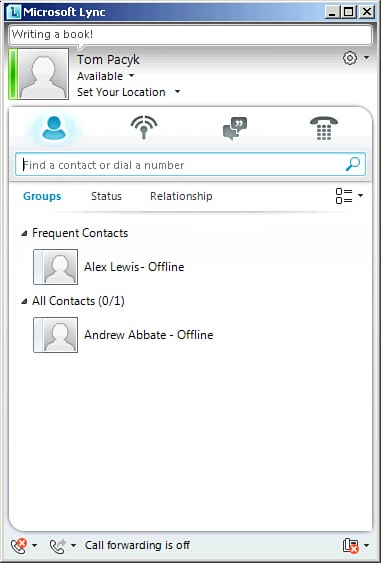Instant Messaging
Along
with presence, collaboration through the use of IMs has been a part of
Lync Server since the beginning. Although IMs are a simple mode of
communication, they can be an excellent way to conduct a conversation in
a quick manner without needing to resort to e-mail or a phone call.
In Lync Server, IM is not unlike
IM conversations that use other providers, but the main advantage to IM
with Lync Server instead of a public solution is that all the messaging
is encrypted through TLS connections to the servers and an organization
has complete control over how the system is used. This means that a
rogue user on your network can’t start a packet sniffer application and
read messages sent between two other users.
Note
Although it might be an
acceptable compromise on an internal network, this security in signaling
extends to remote access scenarios too, ensuring conversations that
take place across the Internet are also encrypted.
The Lync Server endpoints
support the same kind of features found in many other IM clients, such
as rich text, emoticons, and saving messages. The end user and security
features enable an organization to standardize on a single messaging
client such as Lync instead of multiple clients and services. Figure 1 shows the new Lync interface, which should be familiar to any user who has used other IM products.

Note
A
long-standing issue with many IM applications is that users think the
conversation is not captured unless conducted through e-mail. Through
integration with Microsoft Office Outlook, IM conversations can be saved
automatically to the user’s Microsoft Exchange mailbox. These
conversations are then searchable in the same way that e-mail messages
are, so users can reference them at any time.
Web Conferencing
Lync Server gives users the ability to create or join virtual meetings referred to as web conferences,
including attendees from inside the organization or guest users without
an account in the Lync Server environment. In prior versions of Lync
Server, the web conferencing experience was separated into the Live
Meeting client. However, in Lync Server, the web conferencing experience
has been unified and is now conducted through the same Lync client
instead of through a required, separate download and installation of
Live Meeting. Many of the same features from the previous release exist,
and some additional capabilities have been added. These new
capabilities include
Desktop Sharing—
Enables users to share an entire desktop or just a single monitor when
multiple monitors are connected. When users select a specific monitor to
share, the edges of the screen glow to give a visual clue of which
monitor is about to be presented.
Application Sharing—
Users can share only a specific application that runs on the desktop.
Attendees see only the application shared by the presenter instead of an
entire desktop or monitor.
Presentation—
Upload and share a PowerPoint presentation. Rather than share
PowerPoint through the application-sharing feature, this option can be
used to give a better experience for attendees. It has transitions and
slide change controls for the presenter.
Polls—
Presenters can conduct a questionnaire with responses attendees can
select by clicking the options. The poll tallies the results for the
presenter to see or for all attendees to see.
Whiteboard—
The whiteboard in Lync Server has greatly improved and is now
reminiscent of Microsoft Office OneNote where text blocks can be
inserted or moved easily and images can be inserted and dragged around
the screen. Whiteboard sessions can be shared among multiple presenters
and saved later for reference.
Web conferencing attendees have a
number of different client options for joining meetings; these offer
varying degrees of functionality. They are
Lync—
The full client can be used to join a conference or act as a presenter.
This is the most complete end-user experience and has no restrictions.
Lync Attendee—
This application is a subset of the Lync application and offers full
web and A/V conferencing capabilities, but can be used only for joining a
meeting.
Note
Lync
Attendee is a free download that is available to any user, even if she
does not belong to the organization. However, it does require installing
the client.
Lync Web App—
This web application is a third option for joining web conferences.
Lync Web App is a browser-based Silverlight application that requires no
installation other than the Silverlight prerequisite. Participants can
access Lync Web App through the meeting link that can be used by
anonymous, external participants or by authenticated users who want to
sign in. Lync Web App does not offer any audio or video capabilities,
but users can provide a phone number for the conferencing server to call
them in to the meeting. Any user with a browser and Silverlight can
join a meeting this way regardless of operating system or platform.